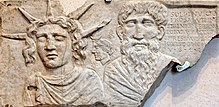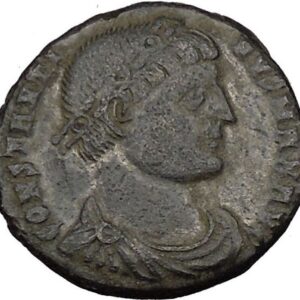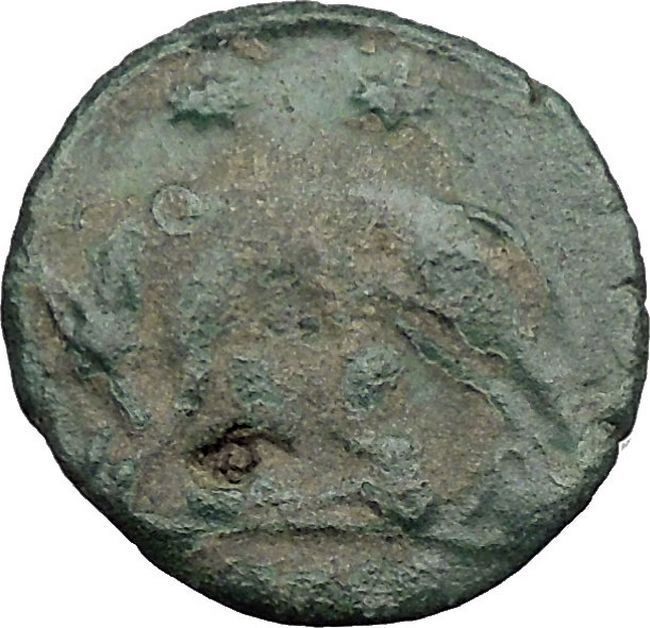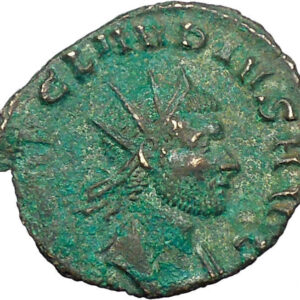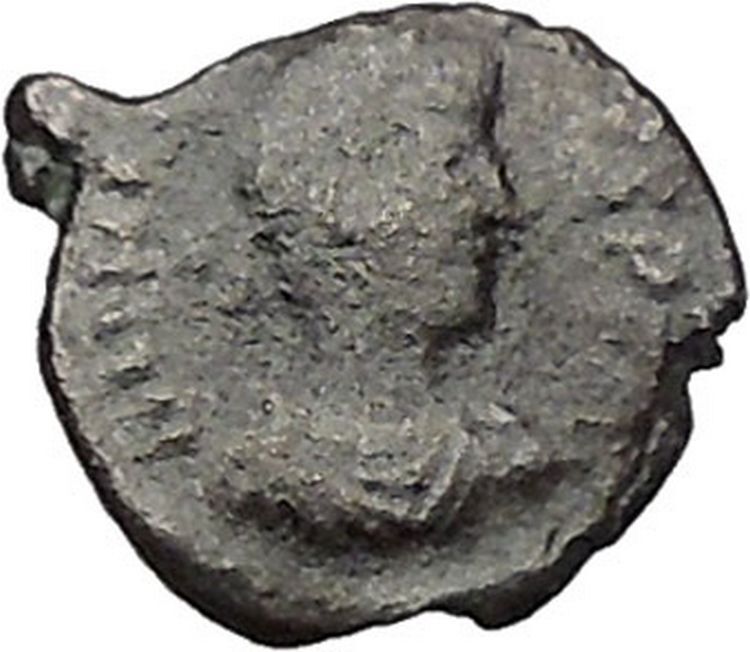|
Elagabalus
–
Roman Emperor
: 218-222 A.D. –
Silver Denarius 20mm (2.58 grams) Rome mint: 220 A.D.
Reference: RIC 28b, C 153
IMPANTONINVSPIVSAVG – Laureate, draped bust right.
PMTRPIIICOSIIIPP – Sol advancing left, raising hand and holding whip.
Star in left field.
You are bidding on the exact item pictured,
provided with a Certificate of Authenticity and Lifetime Guarantee of
Authenticity.
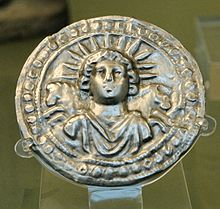
Roman Imperial
repoussé
silver
disc of Sol Invictus (3rd
century), found at
Pessinus
(British
Museum) Sol Invictus (“Unconquered Sun”) was the official
sun god
of the later
Roman Empire
and a patron of soldiers. In 274
the Roman emperor
Aurelian
made it an official
cult alongside the traditional Roman cults. Scholars disagree whether
the new deity was a refoundation of the ancient
Latin
cult of
Sol
,
a revival of the cult of
Elagabalus
or completely new.The god was
favored by emperors after Aurelian and appeared on their coins until
Constantine
.The last inscription referring to
Sol Invictus dates to 387 AD and there were enough devotees in the 5th century
that
Augustine
found it necessary to preach against
them.
It is commonly claimed that the date of 25 December for
Christmas
was selected in order to correspond
with the Roman festival of Dies Natalis Solis Invicti, or “Birthday of
the Unconquered Sun”, but this view is challenged
Invictus as
epithet
Invictus
(“Unconquered, Invincible”) was an
epithet
for
several deities
of
classical Roman religion
, including the supreme
deity
Jupiter
, the war god
Mars
,
Hercules
,
Apollo
and
Silvanus
.[8]
Invictus was in use from the 3rd century BC, and was well-established as
a
cult
title when applied to
Mithras
from the 2nd century onwards. It has a
clear association[vague]
with solar deities and solar monism; as such, it became the preferred epithet of
Rome’s traditional
Sol
and the novel, short-lived Roman state cult
to
Elagabalus
, an
Emesan
solar deity who headed Rome’s official
pantheon under his
namesake emperor
.
The earliest dated use of Sol invictus is in a dedication from Rome,
AD 158. Another, stylistically dated to the 2nd century AD, is inscribed on a
Roman
phalera
: “inventori lucis soli invicto
augusto” (to the contriver of light, sol invictus augustus ). Here “augustus”
is most likely a further epithet of Sol as “august” (an elevated being, divine
or close to divinity), though the association of Sol with the Imperial house
would have been unmistakable and was already established in iconography and
stoic monism. These are the earliest attested examples of Sol as invictus,
but in AD 102 a certain
Anicetus
restored a shrine of Sol; Hijmans
(2009, 486, n. 22) is tempted “to link Anicetus’ predilection for Sol with his
name, the
Latinized
form of the Greek word ἀνίκητος,
which means invictus“.
Elagabalus
The first sun god consistently termed invictus was the
provincial Syrian
god
Elagabalus
. According to the
Historia Augusta
, the
teenaged Severan heir
adopted the name of his
deity and brought his cult image from Emesa to Rome. Once installed as emperor,
he neglected Rome’s traditional State deities and promoted his own as Rome’s
most powerful deity. This ended with his murder in 222.
The Historia Augusta refers to the deity Elagabalus as “also called
Jupiter and Sol” (fuit autem Heliogabali vel Iovis vel Solis).This has
been seen as an abortive attempt to impose the Syrian sun god on Rome;
but because it is now clear that the Roman cult of Sol remained
firmly established in Rome throughout the Roman period,this Syrian
Sol Elagabalus
has become no more relevant to
our understanding of the Roman
Sol
than, for example, the Syrian
Jupiter Dolichenus
is for our understanding of
the Roman Jupiter.
Aurelian
The Roman gens
Aurelian was associated with the cult
of Sol. After his victories in the East, the Emperor
Aurelian
thoroughly reformed the Roman cult of
Sol, elevating the sun-god to one of the premier divinities of the Empire. Where
previously priests of Sol had been simply
sacerdotes
and tended to belong to lower
ranks of Roman society, they were now pontifices and members of the new
college of pontifices
instituted by Aurelian.
Every pontifex of Sol was a member of the senatorial elite, indicating that the
priesthood of Sol was now highly prestigious. Almost all these senators held
other priesthoods as well, however, and some of these other priesthoods take
precedence in the inscriptions in which they are listed, suggesting that they
were considered more prestigious than the priesthood of Sol.Aurelian also built
a new temple for Sol, bringing the total number of temples for the god in Rome
to (at least) four[21]
He also instituted games in honor of the sun god, held every four years from AD
274 onwards.
The identity of Aurelian’s Sol Invictus has long been a subject of scholarly
debate. Based on the
Historia Augusta
, some scholars have argued
that it was based on
Sol Elagablus
(or Elagabla) of
Emesa
. Others, basing their argument on
Zosimus
, suggest that it was based on the
Helios
, the solar god of
Palmyra
on the grounds that Aurelian placed and
consecrated a cult statue of Helios looted from Palmyra in the temple of Sol
Invictus. Professor Gary Forsythe discusses these arguments and add a third more
recent one based on the work of Steven Hijmans. Hijmans argues that Aurelian’s
solar deity was simply the traditional Greco-Roman Sol Invictus.
Constantine
Emperors portrayed Sol Invictus on their official coinage, with a wide range
of legends, only a few of which incorporated the epithet invictus, such
as the legend SOLI INVICTO COMITI, claiming the Unconquered Sun
as a companion to the Emperor, used with particular frequency by Constantine.
Statuettes of Sol Invictus, carried by the standard-bearers,
appear in three places in reliefs on the
Arch of Constantine
. Constantine’s official
coinage continues to bear images of Sol until 325/6. A
solidus
of Constantine as well as a gold
medallion from his reign depict the Emperor’s bust in profile twinned (“jugate”)
with Sol Invictus, with the legend INVICTUS CONSTANTINUS
Constantine decreed (March 7, 321) dies Solis—day of the sun, “Sunday“—as
the Roman day of rest [CJ3.12.2]:
- On the venerable day of the Sun let the magistrates and people residing
in cities rest, and let all workshops be closed. In the country however
persons engaged in agriculture may freely and lawfully continue their
pursuits because it often happens that another day is not suitable for
grain-sowing or vine planting; lest by neglecting the proper moment for such
operations the bounty of heaven should be lost.
Constantine’s triumphal arch was carefully positioned to align with the
colossal statue of Sol
by the
Colosseum
, so that Sol formed the dominant
backdrop when seen from the direction of the main approach towards the arch.[26]
Sol and the
other Roman Emperors
Berrens
deals with coin-evidence of Imperial connection to the Solar
cult. Sol is depicted sporadically on imperial coins in the 1st and 2nd
centuries AD, then more frequently from
Septimius Severus
onwards until AD 325/6.
Sol invictus appears on coin legends from AD 261, well before the reign of
Aurelian.
Connections between the imperial radiate crown and the cult of
Sol are postulated.
Augustus
was posthumously depicted with radiate
crown, as were living emperors from
Nero (after AD 65) to
Constantine
. Some modern scholarship interprets
the imperial radiate crown as a divine, solar association rather than an overt
symbol of Sol; Bergmann calls it a pseudo-object designed to disguise the divine
and solar connotations that would otherwise be politically controversial
but there is broad agreement that coin-images showing the
imperial radiate crown are stylistically distinct from those of the solar crown
of rays; the imperial radiate crown is depicted as a real object rather than as
symbolic light. Hijmans argues that the Imperial radiate crown represents the
honorary wreath awarded to
Augustus
, perhaps posthumously, to commemorate
his victory at the
battle of Actium
; he points out that
henceforth, living emperors were depicted with radiate crowns, but state divi
were not. To Hijmans this implies the radiate crown of living emperors as a link
to Augustus. His successors automatically inherited (or sometimes acquired) the
same offices and honours due to Octavian as “saviour of the Republic” through
his victory at Actium, piously attributed to Apollo-Helios. Wreaths awarded to
victors at the Actian Games were radiate.
Sol
Invictus and Christianity and Judaism

Mosaic of Christ as
Sol
or
Apollo-Helios
in Mausoleum M in the
pre-4th-century necropolis beneath[33]
St. Peter’s in the Vatican
, which
many interpret as representing Christ
The
Philocalian calendar
of AD 354 gives a festival
of “Natalis Invicti” on 25 December. There is limited evidence that this
festival was celebrated before the mid-4th century.
The idea that Christians chose to celebrate the birth of Jesus on 25 December
because this was the date of an already existing festival of the Sol Invictus
was expressed in an annotation to a manuscript of a work by 12th-century Syrian
bishop
Jacob Bar-Salibi
. The scribe who added it
wrote: “It was a custom of the Pagans to celebrate on the same 25 December the
birthday of the Sun, at which they kindled lights in token of festivity. In
these solemnities and revelries the Christians also took part. Accordingly when
the doctors of the Church perceived that the Christians had a leaning to this
festival, they took counsel and resolved that the true Nativity should be
solemnised on that day.”
This idea became popular especially in the 18th and 19th centuries
and is still widely accepted.
In the judgement of the Church of England Liturgical Commission, this view
has been seriously challenged
by a view based on an old tradition, according to which the
date of Christmas was fixed at nine months after 25 March, the date of the
vernal equinox, on which the
Annunciation
was celebrated.
The Jewish calendar date of 14 Nisan was believed to be that
of the beginning of creation, as well as of the Exodus and so of Passover, and
Christians held that the new creation, both the death of Jesus and the beginning
of his human life, occurred on the same date, which some put at 25 March in the
Julian calendar.[40][42][43]
It was a traditional Jewish belief that great men lived a whole number of years,
without fractions, so that Jesus was considered to have been conceived on 25
March, as he died on 25 March, which was calculated to have coincided with 14
Nisan.[44]
Sextus Julius Africanus
(c.160 – c.240) gave 25
March as the day of creation and of the conception of Jesus.
The tractate De solstitia et aequinoctia conceptionis et
nativitatis Domini nostri Iesu Christi et Iohannis Baptistae falsely
attributed to
John Chrysostom
also argued that Jesus was
conceived and crucified on the same day of the year and calculated this as 25
March.
A passage of the Commentary on the prophet Daniel by
Hippolytus of Rome
, written in about 204, has
also been appealed to.
Among those who have put forward this view are Louis Duchesne,Thomas J.
Talley, David J. Rothenberg, J. Neil Alexander, and Hugh Wybrew.
Not all scholars who view the celebration of the birth of Jesus on 25
December as motivated by the choice of the winter solstice rather than
calculated on the basis of the belief that he was conceived and died on 25 March
agree that it constituted a deliberate Christianization of a festival of the
Birthday of the Unconquered Sun. Michael Alan Anderson writes:
Both the sun and Christ were said to be born anew on December 25. But
while the solar associations with the birth of Christ created powerful
metaphors, the surviving evidence does not support such a direct association
with the Roman solar festivals. The earliest documentary evidence for the
feast of Christmas makes no mention of the coincidence with the winter
solstice. Thomas Talley has shown that, although the Emperor Aurelian’s
dedication of a temple to the sun god in the Campus Martius (C.E. 274)
probably took place on the ‘Birthday of the Invincible Sun’ on December 25,
the cult of the sun in pagan Rome ironically did not celebrate the winter
solstice nor any of the other quarter-tense days, as one might expect. The
origins of Christmas, then, may not be expressly rooted in the Roman
festival.
The same point is made by Hijmans: “It is cosmic symbolism…which inspired
the Church leadership in Rome to elect the southern solstice, December 25, as
the birthday of Christ … While they were aware that pagans called this day the
‘birthday’ of Sol Invictus, this did not concern them and it did not play any
role in their choice of date for Christmas.” He also states that, “while the
winter solstice on or around December 25 was well established in the Roman
imperial calendar, there is no evidence that a religious celebration of Sol on
that day antedated the celebration of Christmas”.
The Oxford Companion to Christian Thought also remarks on the
uncertainty about the order of precedence between the celebrations of the
Birthday of the Unconquered Sun and the birthday of Jesus: “This ‘calculations’
hypothesis potentially establishes 25 December as a Christian festival before
Aurelian’s decree, which, when promulgated, might have provided for the
Christian feast both opportunity and challenge.”
Susan K. Roll also calls “most extreme” the unproven hypothesis that “would
call Christmas point-blank a ‘christianization’ of Natalis Solis Invicti, a
direct conscious appropriation of the pre-Christian feast, arbitrarily placed on
the same calendar date, assimilating and adapting some of its cosmic symbolism
and abruptly usurping any lingering habitual loyalty that newly-converted
Christians might feel to the feasts of the state gods”.
The comparison of Christ with the astronomical
Sun
is common in ancient Christian writings.
In the 5th century,
Pope Leo I
(the Great) spoke in several sermons
on the Feast of the Nativity of how the celebration of Christ’s birth coincided
with increase of the sun’s position in the sky. An example is: “But this
Nativity which is to be adored in heaven and on earth is suggested to us by no
day more than this when, with the early light still shedding its rays on nature,
there is borne in upon our senses the brightness of this wondrous mystery.
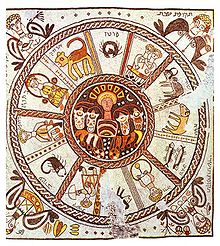
Mosaic in the
Beth Alpha
synagogue, with the sun
in the centre, surrounded by the twelve zodiac constellations and
with the four seasons associated inaccurately with the
constellations
A study of
Augustine of Hippo
remarks that his exhortation
in a Christmas sermon, “Let us celebrate this day as a feast not for the sake of
this sun, which is beheld by believers as much as by ourselves, but for the sake
of him who created the sun”, shows that he was aware of the coincidence of the
celebration of Christmas and the Birthday of the Unconquered Sun, although this
pagan festival was celebrated at only a few places and was originally a
peculiarity of the Roman city calendar. It adds: “He also believes, however,
that there is a reliable tradition which gives 25 December as the actual date of
the birth of our Lord.”
By “the sun of righteousness” in
Malachi 4:2
“the
fathers
, from
Justin
downward, and nearly all the earlier
commentators understand Christ, who is supposed to be described as the
rising sun”.
The
New Testament
itself contains a hymn fragment:
“Awake, O sleeper, and arise from the dead, and Christ will shine on you.”
Clement of Alexandria
wrote of “the Sun of the
Resurrection, he who was born before the dawn, whose beams give light”.
Christians adopted the image of the Sun (Helios
or Sol Invictus) to represent Christ. In this portrayal he is a beardless figure
with a flowing cloak in a chariot drawn by four white horses, as in the mosaic
in Mausoleum M discovered under
Saint Peter’s Basilica
and in an
early-4th-century catacomb fresco.
Clement of Alexandria had spoken of Christ driving his chariot
in this way across the sky. The nimbus of the figure under Saint Peter’s
Basilica is described by some as rayed,
as in traditional pre-Christian representations, but another
has said: “Only the cross-shaped nimbus makes the Christian significance
apparent” (emphasis added). Yet another has interpreted the figure as a
representation of the sun with no explicit religious reference whatever, pagan
or Christian.
The traditional image of the sun is used also in Jewish art. A mosaic floor
in Hamat Tiberias
presents
David
as Helios surrounded by a ring with the
signs of the zodiac
.As well as in Hamat Tiberias, figures of
Helios or Sol Invictus also appear in several of the very few surviving schemes
of decoration surviving from Late Antique
synagogues
, including
Beth Alpha
,
Husefah
(Husefa) and
Naaran
, all now in
Israel
. He is shown in floor mosaics, with the
usual radiate halo, and sometimes in a
quadriga
, in the central roundel of a circular
representation of the zodiac or the seasons. These combinations “may have
represented to an agricultural Jewish community the perpetuation of the annual
cycle of the universe or … the central part of a calendar”.
Elagabalus (Marcus Aurelius Antoninus Augustus, ca. 203 – 11 March
222), also known as Heliogabalus, was
Roman Emperor
from 218 to 222. A member of the
Severan Dynasty
, he was
Syrian
on his mother’s side, the son of
Julia Soaemias
and
Sextus Varius Marcellus
. In his early youth he
served as a priest of the god
Elagabal
(in Latin, Elagabalus) in the
hometown of his mother’s family,
Emesa
. As a private citizen, he was probably
named Sextus Varius Avitus Bassianus. Upon becoming emperor he took the name
Marcus Aurelius Antoninus Augustus. He was called Elagabalus only after his
death.

In 217, the emperor
Caracalla
was
assassinated
and replaced by his
Praetorian prefect
, Marcus Opellius
Macrinus
. Caracalla’s maternal aunt,
Julia Maesa
, successfully instigated a revolt
among the
Third Legion
to have her eldest grandson (and
Caracalla’s cousin), Elagabalus, declared emperor in his place. Macrinus was
defeated on 8 June 218, at the
Battle of Antioch
. Elagabalus, barely fourteen
years old, became emperor, initiating a reign remembered mainly for
sexual scandal
and religious controversy.
Later historians suggest Elagabalus showed a disregard for Roman religious
traditions and sexual taboos. He replaced the traditional head of the
Roman pantheon
,
Jupiter
, with the deity of whom he was high
priest,
Elagabal
. He forced leading members of Rome’s
government to participate in religious rites celebrating this deity, over which
he personally presided. Elagabalus was married as many as five times, lavished
favors on male courtiers popularly thought to have been his lovers, employed a
prototype of
whoopee cushions
at dinner parties, and was
reported to have prostituted himself in the imperial palace. His behavior
estranged the
Praetorian Guard
, the
Senate
, and the common people alike.
Amidst growing opposition, Elagabalus, just 18 years old, was assassinated
and replaced by his cousin
Alexander Severus
on 11 March 222, in a plot
formulated by his grandmother, Julia Maesa, and carried out by disaffected
members of the Praetorian Guard.
Elagabalus developed a reputation among his contemporaries for extreme
eccentricity
,
decadence
and
zealotry
. This tradition has persisted, and in
writers of the early modern age he suffers one of the worst reputations among
Roman emperors.
Edward Gibbon
, for example, wrote that
Elagabalus “abandoned himself to the grossest pleasures and ungoverned fury.”
According to
B.G. Niebuhr
, “The name Elagabalus is branded
in history above all others” because of his “unspeakably disgusting life.”
Family and priesthood
|
Roman imperial dynasties |
Severan dynasty
|
| |
|
Chronology |
|
Septimius Severus
|
193
–198 |
-with
Caracalla
|
198
–209 |
| -with Caracalla and Geta |
209
–211 |
Caracalla
and
Geta
|
211
–211 |
|
Caracalla
|
211
–217 |
Interlude:
Macrinus
|
217
–218 |
|
Elagabalus |
218
–222 |
|
Alexander Severus
|
222
–235 |
|
Dynasty |
Severan dynasty family tree
Category:Severan dynasty
|
|
Succession |
Preceded by
Year of the Five Emperors
|
Followed by
Crisis of the Third Century
|
Elagabalus was born around the year 203[7]
to
Sextus Varius Marcellus
and
Julia Soaemias Bassiana
. His father was
initially a member of the
equestrian
class, but was later elevated to the
rank of senator
. His grandmother
Julia Maesa
was the widow of the
Consul
Gaius
Julius Avitus
Alexianus, the sister of
Julia Domna
, and the sister-in-law of the
emperor
Septimius Severus
.
His mother, Julia Soaemias, was a cousin of the Roman emperor
Caracalla
. Other relatives included his aunt
Julia Avita Mamaea
and uncle
Marcus Julius Gessius Marcianus
, and their son
Alexander Severus
. Elagabalus’s family held
hereditary rights to the priesthood of the sun god Elagabal, of whom Elagabalus
was the high priest
at Emesa (modern
Homs) in
Syria
.
The deity
Elagabalus
was initially venerated at Emesa.
This form of the god’s name is a Latinized version of the Syrian Ilāh hag-Gabal,
which derives from
Ilāh
(“god”) and gabal (“mountain”
(compare
Hebrew
:
גבל gəbul and
Arabic
: جبل
jabal)), resulting in “the God of the Mountain” the Emesene manifestation
of the deity.[9]
The cult of the deity spread to other parts of the Roman Empire in the 2nd
century; a dedication has been found as far away as
Woerden
(Netherlands).[10]
The god was later imported and assimilated with the Roman sun god known as
Sol Indiges
in
republican
times and as
Sol Invictus
during the 2nd and 3rd centuries
CE. In Greek the sun god is
Helios
, hence “Heliogabalus”, a variant of “Elagabalus”.
Rise to power
When the emperor
Macrinus
came to power, Elagabalus’ mother
suppressed the threat against his reign by the family of his assassinated
predecessor, Caracalla, by exiling them—Julia Maesa, her two daughters, and her
eldest grandson Elagabalus—to their estate at Emesa in
Syria
. Almost upon arrival in Syria she began a
plot, with her advisor and Elagabalus’ tutor Gannys, to overthrow Macrinus and
elevate the fourteen-year-old Elagabalus to the imperial throne.
His mother publicly declared that he was the illegitimate son of Caracalla,
therefore due the loyalties of Roman soldiers and senators who had sworn
allegiance to Caracalla. After Julia Maesa displayed her wealth to the
Third Legion
at
Raphana
they swore allegiance to Elagabalus. At
sunrise on 16 May 218,
Publius Valerius Comazon Eutychianus
, commander
of the legion, declared him emperor. To strengthen his legitimacy through
further propaganda, Elagabalus assumed Caracalla’s names, Marcus Aurelius
Antoninus.
In response Macrinus dispatched his
Praetorian prefect
Ulpius Julianus to the
region with a contingent of troops he considered strong enough to crush the
rebellion
. However, this force soon joined the
faction of Elagabalus when, during the battle, they turned on their own
commanders. The officers were killed and Julianus’ head was sent back to the
emperor.
Macrinus now sent letters to the
Senate
denouncing Elagabalus as the False
Antoninus and claiming he was insane. Both
consuls
and other high-ranking members of
Rome’s leadership condemned Elagabalus, and the Senate subsequently declared war
on both Elagabalus and Julia Maesa.
Macrinus and his son, weakened by the desertion of the
Second Legion
due to bribes and promises
circulated by Julia Maesa, were defeated on 8 June 218 at the
Battle of Antioch
by troops commanded by Gannys.
Macrinus fled toward Italy
, disguised as a courier, but was later
intercepted near
Chalcedon
and executed in
Cappadocia
. His son
Diadumenianus
, sent for safety to the
Parthian
court, was captured at
Zeugma
and also put to death.
Elagabalus declared the date of the victory at Antioch to be the beginning of
his reign and assumed the imperial titles without prior senatorial approval,
which violated tradition but was a common practice among 3rd-century emperors
nonetheless. Letters of reconciliation were dispatched to
Rome extending
amnesty
to the Senate and recognizing the laws,
while also condemning the administration of Macrinus and his son.
The senators responded by acknowledging Elagabalus as emperor and accepting
his claim to be the son of Caracalla. Caracalla and Julia Domna were both
deified
by the Senate, both Julia Maesa and
Julia Soaemias were elevated to the rank of
Augustae
,[20]
and the memory of both Macrinus and Diadumenianus was condemned by the Senate.
The former commander of the Third Legion, Comazon, was appointed commander of
the Praetorian Guard.
Emperor
(218–222)

A denarius
commissioned by Elagabalus,
bearing his likeness
Elagabalus and his entourage spent the winter of 218 in
Bithynia
at
Nicomedia
, where the emperor’s religious
beliefs first presented themselves as a problem. The contemporary historian
Cassius Dio
suggests that Gannys was in fact
killed by the new emperor because he was forcing Elagabalus to live “temperately
and prudently.” To help Romans adjust to the idea of having an oriental priest
as emperor, Julia Maesa had a painting of Elagabalus in priestly robes sent to
Rome and hung over a statue of the goddess
Victoria
in the
Senate House
. This placed senators in the
awkward position of having to make offerings to Elagabalus whenever they made
offerings to Victoria.
The legions were dismayed by his behaviour and quickly came to regret having
supported his accession. While Elagabalus was still on his way to Rome, brief
revolts broke out by the
Fourth Legion
at the instigation of
Gellius Maximus
, and by the Third Legion, which
itself had been responsible for the elevation of Elagabalus to the throne, under
the command of Senator
Verus
. The rebellion was quickly put down, and
the Third Legion disbanded.
When the entourage reached Rome in the autumn of 219, Comazon and other
allies of Julia Maesa and Elagabalus were given powerful and lucrative
positions, to the outrage of many senators who did not consider them worthy of
such privileges. After his tenure as
Praetorian prefect
, Comazon would serve as the
city prefect of Rome three times, and as
consul
twice. Elagabalus soon devalued the
Roman currency
. He decreased the silver purity
of the denarius
from 58% to 46.5% — the actual
silver weight dropping from 1.82 grams to 1.41 grams. He also demonetized the
antoninianus
during this period in Rome.
Elagabalus tried to have his presumed lover, the charioteer
Hierocles
, declared
Caesar
, while another alleged lover, the
athlete Aurelius Zoticus, was appointed to the non-administrative but
influential position of Master of the Chamber, or
Cubicularius
.[29]
His offer of amnesty for the Roman upper class was largely honored, though the
jurist
Ulpian
was exiled.
The relationships between Julia Maesa, Julia Soaemias, and Elagabalus were
strong at first. His mother and grandmother became the first women to be allowed
into the Senate, and both received senatorial titles: Soaemias the established
title of Clarissima, and Maesa the more unorthodox Mater Castrorum et
Senatus (“Mother of the army camp and of the Senate”).[20]
While Julia Maesa tried to position herself as the power behind the throne and
thus the most powerful woman in the world, Elagabalus would prove to be highly
independent, set in his ways, and impossible to control.
Religious controversy
Since the reign of
Septimius Severus
,
sun worship
had increased throughout the
Empire. Elagabalus saw this as an opportunity to install Elagabal as the chief
deity of the
Roman pantheon
. The god was renamed
Deus Sol Invictus
, meaning God the
Undefeated Sun, and honored above
Jupiter
.
As a token of respect for Roman religion, however, Elagabalus joined either
Astarte
,
Minerva
,
Urania
, or some combination of the three to
Elagabal as wife. Before constructing a temple in dedication to Elagabal,
Elagabalus placed the meteorite of Elagabal next to the throne of Jupiter at the
temple of Jupiter Optimus Maximus.
He caused further discontent when he himself married the
Vestal Virgin
Aquilia Severa
, claiming the marriage would
produce “godlike children”. This was a flagrant breach of Roman law and
tradition, which held that any Vestal found to have engaged in sexual
intercourse was to be
buried alive
.
A lavish temple called the
Elagabalium
was built on the east face of the
Palatine Hill
to house Elagabal, who was
represented by a black conical
meteorite
from Emesa.
Herodian
wrote “this stone is worshipped as
though it were sent from heaven; on it there are some small projecting pieces
and markings that are pointed out, which the people would like to believe are a
rough picture of the sun, because this is how they see them”.
In order to become the high priest of his new religion, Elagabalus had
himself circumcised.[33]
He forced senators to watch while he danced around the altar of Deus Sol
Invictus to the accompaniment of drums and cymbals.[19]
Each summer solstice
he held a festival dedicated to the
god, which became popular with the masses because of the free food distributed
on such occasions.[34]
During this festival, Elagabalus placed the Emesa stone on a
chariot
adorned with gold and jewels, which he
paraded through the city:
A six horse chariot carried the divinity, the horses huge and flawlessly
white, with expensive gold fittings and rich ornaments. No one held the
reins, and no one rode in the chariot; the vehicle was escorted as if
the god himself were the charioteer. Elagabalus ran backward in front of
the chariot, facing the god and holding the horses’ reins. He made the
whole journey in this reverse fashion, looking up into the face of his
god.
The most sacred relics from the Roman religion were transferred from their
respective shrines to the Elagabalium, including the emblem of the
Great Mother
, the fire of
Vesta
, the
Shields
of the
Salii
and the
Palladium
, so that no other god could be
worshipped except in company with Elagabal.
Sex/gender
controversy

Roman denarius depicting
Aquilia Severa
, the second wife of
Elagabalus. The marriage caused a public outrage because Aquilia was
a
Vestal Virgin
, sworn by Roman law
to celibacy
for 30 years.
Elagabalus’
sexual orientation
and
gender identity
are the subject of much debate.
Elagabalus married and divorced five women, three of whom are known. His first
wife was
Julia Cornelia Paula
; the second was the
Vestal Virgin
Julia Aquilia Severa
.
Within a year, he abandoned her and married
Annia Aurelia Faustina
, a descendant of
Marcus Aurelius
and the widow of a man recently
executed by Elagabalus. He had returned to his second wife Severa by the end of
the year. According to Cassius Dio, his most stable relationship seems to have
been with his chariot
driver, a blond slave from
Caria
named
Hierocles
, whom he referred to as his husband.
The Augustan History claims that he also married a man named Zoticus,
an athlete from Smyrna, in a public ceremony at Rome. Cassius Dio reported that
Elagabalus would paint his eyes,
epilate
his hair and wear wigs before
prostituting
himself in taverns, brothels, and
even in the imperial palace:
Finally, he set aside a room in the palace and there committed his
indecencies, always standing nude at the door of the room, as the
harlots do, and shaking the curtain which hung from gold rings, while in
a soft and melting voice he solicited the passers-by. There were, of
course, men who had been specially instructed to play their part. For,
as in other matters, so in this business, too, he had numerous agents
who sought out those who could best please him by their foulness. He
would collect money from his patrons and give himself airs over his
gains; he would also dispute with his associates in this shameful
occupation, claiming that he had more lovers than they and took in more
money.
Herodian commented that Elagabalus enhanced his natural good looks by the
regular application of cosmetics. He was described as having been “delighted to
be called the mistress, the wife, the queen of Hierocles” and was reported to
have offered vast sums of money to any physician who could equip him with female
genitalia. Elagabalus has been characterized by some modern writers as
transgender
, perhaps
transsexual
.
Fall from power
By 221 Elagabalus’ eccentricities, particularly his relationship with
Hierocles, increasingly provoked the soldiers of the
Praetorian Guard
. When Elagabalus’ grandmother
Julia Maesa perceived that popular support for the emperor was waning, she
decided that he and his mother, who had encouraged his religious practices, had
to be replaced.[26]
As alternatives, she turned to her other daughter,
Julia Avita Mamaea
, and her daughter’s son, the
thirteen-year-old
Severus Alexander
.
Prevailing on Elagabalus, she arranged that he appoint his cousin Alexander
as his heir and be given the title of Caesar. Alexander shared the
consulship with the emperor that year. However, Elagabalus reconsidered this
arrangement when he began to suspect that the Praetorian Guard preferred his
cousin above himself.
Following the failure of various attempts on Alexander’s life, Elagabalus
stripped his cousin of his titles, revoked his consulship, and circulated the
news that Alexander was near death, in order to see how the Praetorians would
react. A riot ensued, and the guard demanded to see Elagabalus and Alexander in
the
Praetorian camp
.
Assassination
The emperor complied and on 11 March 222 he publicly presented his cousin
along with his own mother, Julia Soaemias. On their arrival the soldiers started
cheering Alexander while ignoring Elagabalus, who ordered the summary arrest and
execution of anyone who had taken part in this display of insubordination. In
response, members of the
Praetorian Guard
attacked Elagabalus and his
mother:
So he made an attempt to flee, and would have got away somewhere by
being placed in a chest, had he not been discovered and slain, at the
age of 18. His mother, who embraced him and clung tightly to him,
perished with him; their heads were cut off and their bodies, after
being stripped naked, were first dragged all over the city, then the
mother’s body was cast aside somewhere or other while his was thrown
into the [Tiber].
Following his assassination, many associates of Elagabalus were killed or
deposed, including Hierocles and Comazon.[44]
His religious edicts were reversed and the stone of Elagabal was sent back to
Emesa
. Women were again barred from attending
meetings of the Senate.[31][46]
The practice of
damnatio memoriae
—erasing from the public
record a disgraced personage formerly of note—was systematically applied in his
case.
Sources
Augustan History
The source of many of these stories of Elagabalus’s depravity is the
Augustan History
(Historia Augusta),
which includes controversial claims. The Historia Augusta was most likely
written toward the end of the 4th century during the reign of emperor
Theodosius I
. The life of Elagabalus as
described in the Augustan History is of uncertain historical merit.[50]
Sections 13 to 17, relating to the fall of Elagabalus, are less controversial
among historians.
Cassius Dio
Sources often considered more credible than the Augustan History
include the contemporary historians
Cassius Dio
and Herodian. Cassius Dio lived
from the second half of the 2nd century until sometime after 229. Born into a
patrician
family, he spent the greater part of
his life in public service. He was a senator under emperor
Commodus
and governor of
Smyrna
after the death of
Septimius Severus
. Afterwards he served as
suffect consul around 205, and as proconsul in
Africa
and
Pannonia
.
Alexander Severus held him in high esteem and made him his consul again. His
Roman History spans nearly a
millennium
, from the arrival of
Aeneas
in Italy until the year 229. As a
contemporary of Elagabalus, Cassius Dio’s account of his reign is generally
considered more reliable than the Augustan History, although by his own
admission Dio spent the greater part of the relevant period outside of Rome and
had to rely on second-hand accounts.
Furthermore, the political climate in the aftermath of Elagabalus’ reign, as
well as Dio’s own position within the government of Alexander, likely influenced
the truth of this part of his history for the worse. Dio regularly refers to
Elagabalus as
Sardanapalus
, partly to distinguish him from
his divine namesake,[53]
but chiefly to do his part in maintaining the
damnatio memoriae
enforced after the
emperor’s death and to associate him with another autocrat notorious for a
debauched life.
Herodian

Medal of Elagabalus,
Louvre Museum
.
Another contemporary of Elagabalus was
Herodian
, who was a minor Roman civil servant
who lived from c. 170 until 240. His work, History of the Roman Empire since
Marcus Aurelius, commonly abbreviated as Roman History, is an
eyewitness account of the reign of
Commodus
until the beginning of the reign of
Gordian III
. His work largely overlaps with
Dio’s own Roman History, but both texts seem to be independently
consistent with each other.
Although Herodian is not deemed as reliable as Cassius Dio, his lack of
literary and scholarly pretensions make him less biased than senatorial
historians. Herodian is considered the most important source for the religious
reforms which took place during the reign of Elagabalus, which have been
confirmed by
numismatic
and
archaeological
evidence.
Edward Gibbon and other, later historians
For readers of the modern age,
The History of the Decline and Fall of the Roman Empire
by Edward Gibbon
(1737–94) further cemented the
scandalous reputation of Elagabalus. Gibbon not only accepted and expressed
outrage at the allegations of the ancient historians, but might have added some
details of his own; he is the first historian known to state that Gannys was a
eunuch, for example.[59]
Gibbon wrote:
To confound the order of the season and climate, to sport with the
passions and prejudices of his subjects, and to subvert every law of
nature and decency, were in the number of his most delicious amusements.
A long train of concubines, and a rapid succession of wives, among whom
was a vestal virgin, ravished by force from her sacred asylum, were
insufficient to satisfy the impotence of his passions. The master of the
Roman world affected to copy the manners and dress of the female sex,
preferring the distaff to the sceptre, and dishonored the principal
dignities of the empire by distributing them among his numerous lovers;
one of whom was publicly invested with the title and authority of the
emperor’s, or, as he more properly styled himself, the empress’s
husband. It may seem probable, the vices and follies of Elagabalus have
been adorned by fancy, and blackened by prejudice. Yet, confining
ourselves to the public scenes displayed before the Roman people, and
attested by grave and contemporary historians, their inexpressible
infamy surpasses that of any other age or country.
Two hundred years after the age of Pliny, the use of pure, or even of
mixed silks, was confined to the female sex, till the opulent citizens
of Rome and the provinces were insensibly familiarized with the example
of Elagabalus, the first who, by this effeminate habit, had sullied the
dignity of an emperor and a man.
Some recent historians argue for a more favorable picture of his life and
reign. Martijn Icks in Images of Elagabalus (2008; republished as The
Crimes of Elagabalus in 2012) doubts the reliability of the ancient sources
and argues that it was the emperor’s unorthodox religious policies that
alienated the power elite of Rome, to the point that his grandmother saw fit to
eliminate him and replace him with his cousin. Leonardo de Arrizabalaga y Prado,
in The Emperor Elagabalus: Fact of Fiction? (2008), is also critical of
the ancient historians and speculates that neither religion nor sexuality played
a role in the fall of the young emperor, who was simply the loser in a power
struggle within the imperial family; the loyalty of the Praetorian Guards was up
for sale, and Julia Maesa had the resources to outmaneuver and outbribe her
grandson. According to this version, once Elagabalus, his mother, and his
immediate circle had been murdered, a wholesale propaganda war against his
memory resulted in a vicious caricature which has persisted to the present,
repeated and often embellished by later historians displaying their own
prejudices against effeminacy and other vices which Elagabalus had come to
epitomize.
Legacy

Elagabalus on a wall painting at castle Forchtenstein
Due to the ancient tradition about him, Elagabalus became something of an
(anti-)hero in the
Decadent movement
of the late 19th century. He
often appears in literature and other creative media as the epitome of a young,
amoral aesthete. His life and character have informed or at least inspired many
famous works of art, by Decadents, even by contemporary artists. The most
notable of these works include:
Poems,
Novels, and Biographies
Plays
-
Zygmunt Krasiński
. “Irydion”
(1836), in which Elagabalus is portrayed as a cruel tyrant
-
Mencken
, H.L. and
Nathan, George Jean
.
Heliogabalus A Buffoonery in Three Acts.
New York: Alfred A. Knopf, 1920
- de Escobar Fagundes, C.H. Heliogabalo: O Sol é a Pátria. Ed.
Devir. Rio de Janeiro, 1980
- Gilbert, S.
Heliogabalus: A Love Story.
Toronto, Cabaret Theatre Company, 2002
- Ferreyra, Shawn.
Elagabalus, Emperor of Rome
, 2008
- Arelis.
Heliogabalus
(2008)
Paintings
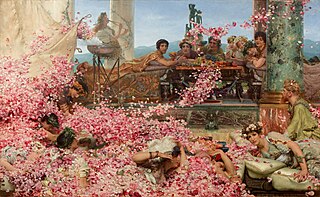
The Roses of Heliogabalus
,
Lawrence Alma-Tadema
, 1888.
Heliogabalus, High Priest of the Sun
(1866), by the English decadent
Simeon Solomon
- One of the most notorious incidents laid to his account is immortalized
in the 19th-century painting
The Roses of Heliogabalus
(1888), by
the Anglo-Dutch academician Sir
Lawrence Alma-Tadema
. It shows guests at
one of his extravagant dinner parties smothered under a mass of “violets and
other flowers” dropped from above.
Lui
(1906), by
Gustav-Adolf Mossa
- Heliogabalus (1974), by
Anselm Kiefer
Antonin Artaud Heliogabalus
(2010–11),
by
Anselm Kiefer
Music
- Eliogabalo
, an opera by Venetian
Baroque composer
Francesco Cavalli
(1667)
- Heliogabale, an opera by French composer
Déodat de Séverac
(1910)
Heliogabalus Imperator
(Emperor
Heliogabalus), an orchestral work by the German composer
Hans Werner Henze
(1972)
Six Litanies for Heliogabalus
, by the
composer and saxophonist
John Zorn
(2007)
Dance
- Héliogabale, a contemporary dance choreographed by
Maurice Béjart
Film
Héliogabale
, a 1909
silent film
by the French director
André Calmettes
-
Héliogabale, ou L’orgie romaine
, a
1911 silent
short
by the French director
Louis Feuillade
|






